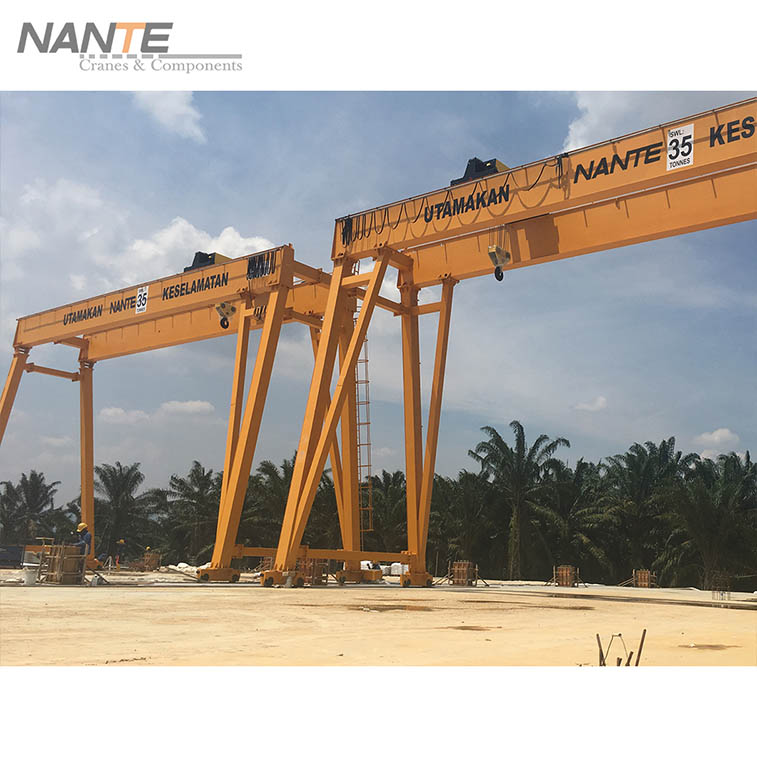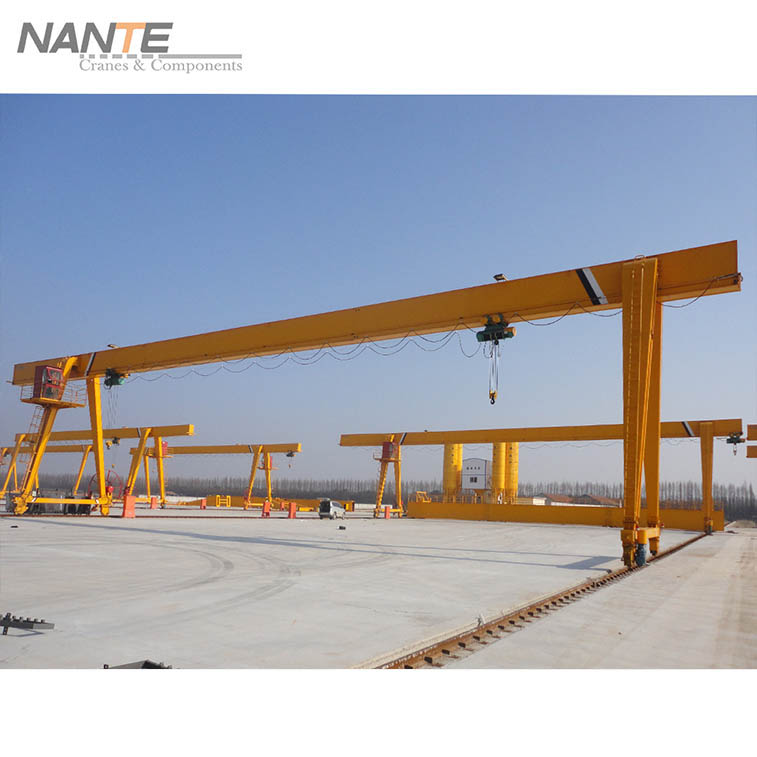What Is a Gantry Crane?
Date: 2024-01-26 Share:
Gantry crane is a bridge type crane, which is characterized by its horizontal bridge set on two legs, shaped like a gantry. This crane is mainly used in open storage yards, dockyards, power stations, ports and railway terminals for handling and installation operations. Main structure of gantry crane includes hoisting mechanism, trolley running mechanism and bridge structure, which are similar to overhead crane.

The characteristics of gantry cranes are:
The distance span is large, and the hoisting mechanism is mostly driven separately to prevent skewed operation.
The outriggers on both sides of the bridge are usually rigid outriggers, but flexible outriggers may be used when the span exceeds 30 meters.
The lifting trolley can run on the bridge, and some lifting trolleys are jib cranes themselves. Gantry cranes have a large wind area, so they will be fitted with wind gauges and rail clamps that are interlocked with the running mechanism.
It has a metal structure like a portal frame, with two legs mounted under the load-bearing main beam, allowing it to travel directly on the ground track.
In general, gantry cranes are widely used in port cargo yards due to their advantages of high site utilization, wide operating range, wide adaptability and versatility.
Gantry cranes have lifting mechanism, trolley running mechanism and bridge structure. Due to the large span, the running mechanism of the crane is mostly driven separately to prevent the crane from running askew, increasing resistance and even accidents. The lifting trolley of the gantry crane runs on the bridge, and some lifting trolleys are cantilever cranes.
The outriggers on both sides of the bridge are generally rigid outriggers. If the distance span is more than 30 meters, often one side of the rigid outriggers, while the other side of the flexible outriggers through the ball hinge connected to the bridge, so that the gantry becomes a stationary system. This static system can avoid the additional stress caused by the lateral thrust of the external load, and it can also compensate for the temperature deformation of the bridge longitudinally when subjected to a large area of wind, in order to prevent slipping or overturning under the action of strong winds.
In order to prevent the crane from sliding or tipping under the action of strong winds, a wind gauge and a crane rail clamp interlocked with the operating mechanism are installed on the crane. The bridge can be used without a cantilever at both ends or with a cantilever at one or both ends to extend the operating range.

Gantry Cranes vs. Overhead Cranes
Gantry cranes and overhead cranes have many similarities in structure and function, but there are also some significant differences:
Support structure: the support structure of overhead cranes is mainly bridges, which are mainly used in indoor or outdoor factories, warehouses and other places. Gantry cranes, on the other hand, bear the work load through an independent support structure, and they are mainly used in outdoor yards, wharves and other places.
Installation: overhead cranes are usually installed directly in the building, and if the height of the equipment exceeds the height of the building, structural adjustment is required. While gantry cranes must be installed outside the entire building.
Transportation: Overhead cranes can be divided into trackless and tracked types, the former can be removed at will and used on site. Gantry cranes, on the other hand, must be assembled.
Operational flexibility: overhead cranes are more flexible and can be operated in the shortest possible time. Gantry cranes, on the other hand, require more skills and expertise to operate and take longer to operate.
Uses and applicable occasions: overhead cranes are suitable for larger spans and lighter loads. And gantry cranes are suitable for larger spans and heavier loads.
In summary, overhead cranes and gantry cranes have a lot of similarities in function and use, the main difference lies in their support structure and use of occasions.

Why Use Nante Gantry Cranes?
Nantes Gantry Crane is a kind of equipment used for loading, unloading and handling heavy loads, and its advantages mainly include the following aspects:
High efficiency: Nante gantry cranes have high efficient working capacity, can quickly complete a large number of loading, unloading and handling work, greatly improving the efficiency of logistics.
High load capacity: Nante gantry cranes have a high load capacity and can easily handle a variety of heavy goods to meet the needs of various heavy-duty loading and unloading.
Easy to operation and maintenance: Nantes gantry cranes are easy to operate with intelligent control system and friendly operation interface. Meanwhile, Nante gantry cranes have lower maintenance costs and longer service life.
Energy saving and environmental protection: Nante Gantry Crane adopts advanced energy-saving technology to ensure efficient operation while reducing energy consumption and minimizing the impact on the environment
High flexibility: Nante gantry cranes can quickly adapt to a variety of working environments and loading and unloading needs, with a high flexibility and adaptability
Safe and reliable: Nante gantry crane in the design and manufacturing process emphasizes safety and reliability, equipped with a variety of safety protection devices to ensure the safety of operators and equipment
Nante gantry crane has the advantages of high efficiency, high load capacity, high stability, easy operation and maintenance, energy-saving and environmentally friendly, high flexibility, safety and reliability, and is widely used in ports, docks, logistics parks and other occasions.
Nante Gantry Crane Products
Nante can offer the overhead crane with different structure mode and capacity like:
- 1-20t Single Girder Gantry Crane
- 2t-63t Double Girder Gantry Crane with Hoist
- 10t-300t Double Girder Gantry Crane with Open winch
- 5t-32t Semi Gantry Crane
 English
English






